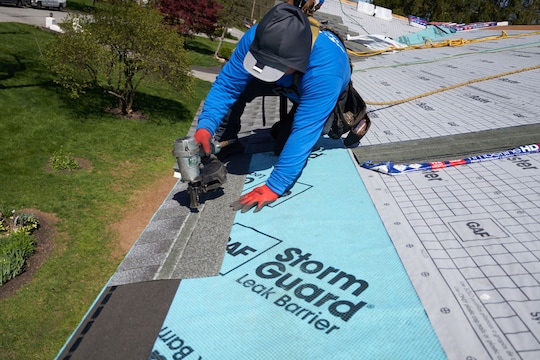
Roofing contractors, it's time to ramp up your roofing social media. Whether you like it or not, the business world today requires a social media presence. Why? Because social media isn't just for saying hi. It's how customers make decisions—like who should install their new roof.
Before even calling for quotes, most customers research online reputations by looking at social media profiles. Property owners use social media to make purchasing decisions and learn if you're a brand they can trust.
For example, did you know 90% of Instagram's 1 billion users follow at least one business account, and 60% say they discover new products on the platform? Or that 78% of U.S. consumers made purchases through discoveries on Facebook in 2018?
That means sharing news about new roofing technology, posting photos of successful roof installations, and engaging with customers online should be a crucial part of your marketing strategy. Here are some simple steps to help you make the most of social media marketing.
Building an Online Community
Roofing keeps you busy, but it's important to make time for social media. You can get started by setting aside 15-20 minutes each day to post, respond to comments, and engage with other people's posts. This organic marketing pays off over time by giving you a credible social media presence. Try these best practices for roofing social media success:
- Build your brand identity: Help potential customers recognize you anywhere they find you online. To ensure you have a consistent brand identity, ask yourself these questions:
- On each social media profile, are my company logos the same, is the wording similar in tone, do I use the same brand colors, and are photos of staff members consistent?
- Is my business contact information and website easy to find and up-to-date on all of my profiles?
- Create community: Follow and engage with a range of users, from home remodeling influencers to large roofing companies to individual customers. Always tag relevant partners (like GAF) in posts so they can share their favorites with their followers and increase your visibility. Additionally, you should get permission from property owners to post photos featuring their homes or buildings, or encourage them to share photos and tag your business page. When they share those photos with their followers, you get free marketing!
- Engage customers: Homeowners and building owners use social media to ask customer service questions, debut completed projects, rave or rant about experiences, and give advice to friends or colleagues looking for a new roof. Respond to all comments and queries, especially the unhappy ones. Taking responsibility and showing you're invested in customer service tells potential clients that you're serious about their satisfaction.
- Use hashtags: A hashtag is any word with the # symbol placed directly in front of it. People search by hashtags for topics they're interested in. You can weave hashtags into captions or compile them at the end of posts. Try using hashtags like #roofing, #roofersofinstagram, #roofingcontractor, #roofingcompany, #roofrepair, and #MyGAFRoof to get visibility. Hashtags are especially important for Instagram and Twitter posts. On Instagram, add 3-5 relevant hashtags. For Twitter, 2-3 targeted hashtags will do.
- Be socially conscious: Customers like companies that better their communities. Use social media to show how you give back, whether it's participating in charity efforts like local food drives or partnering with organizations like Habitat for Humanity and Team Rubicon. Remember to tag partner organizations.
Choosing Roofing Social Media Sites
Each day, 3.8 billion active users spend, on average, nearly 2.5 hours on social media sites. Different sites help you connect with different audiences, and you can tailor content—including blog posts, photos, videos, and news stories—to your demographic. Facebook and Instagram are effective places to start if you're new to social marketing. Here's more on the top sites for roofing social media:
- Facebook: 69% of U.S. adults are on Facebook. They write company reviews, engage with brands, and peruse business profiles to check credibility. To engage with these users, get permission to post before and after photos of roof installations, videos of your workers in action, testimonials from happy clients, and blog articles that will interest customers. Tagging businesses or people who are part of the post will help you build relationships while boosting your visibility.
- Instagram: 67% of people age 18-29 and 57% of people age 30-49 are active Instagram users. These are your current and future customers! Get permission to post before and after roofing portfolios, video highlights of company employees, video clips showcasing the roofing life in Instagram Stories, and news about upcoming events.
- YouTube: 73% of U.S. adults use this video site. Creating content for YouTube requires more time than a quick post to Facebook, but informational roofing videos can establish you as an industry leader and a go-to for DIY homeowners.
- LinkedIn: Use this professional networking site to engage with business peers, learn and share roofing industry thought leadership, and build business connections.
- Twitter: Post your company updates, retweet industry news, and connect with local media when participating in community events.
Post, tag partners, use hashtags, and engage with customers, and over time you'll see the payoff. To get an extra boost, follow GAF on social media —Facebook, Instagram, LinkedIn, Twitter, and YouTube—and tag #MyGAFRoof in photos of your projects that use GAF materials for a chance to be featured on GAF's social pages.
Building a social presence may feel like a chore, but by following some best practices and investing just a few minutes a day, you can build a strong social media presence that instills trust in potential customers.
Once you have your social media in motion, you may want to look into using online reviews for roofing reputation management next. For more tips and solutions that can help you achieve your business goals, check out GAF's resources to grow your business.



